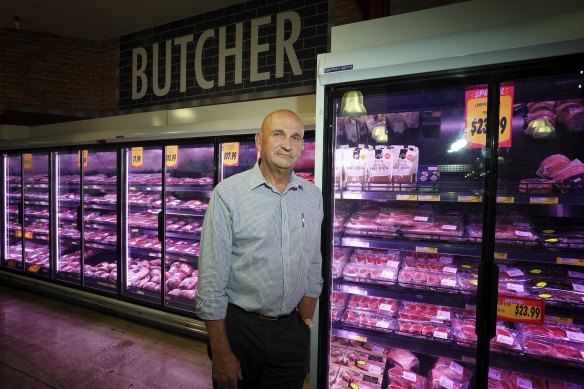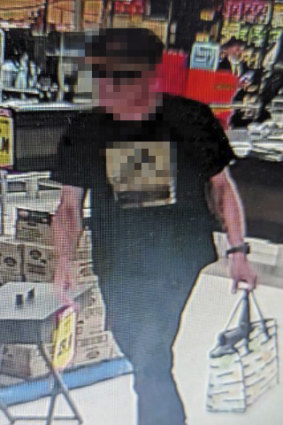This was published 11 months ago
‘These people are stealing for a day job’: Professional shoplifters target supermarket meat
A significant spike in meat theft from supermarkets has been linked to organised retail crime groups who are “swarming” shops.
Meat theft increased by 85 per cent between 2022 and 2023, according to data from retail crime intelligence platform Auror, which works with companies such as Coles, Bunnings and Woolworths.
There were more than 67,000 incidents of meat theft recorded on the platform nationally last year. Pork was the most popular meat to steal, with thefts increasing by 35 per cent, followed by lamb at 31 per cent and beef at 15 per cent.

IGA owner Neal Morgan says his store has been targetted by meat thieves.Credit: Luis Enrique Ascui
Auror chief customer officer Rhod Thomas said the majority of retail crime was perpetrated by organised, professional individuals – 60 per cent of in-store thefts were conducted by just one cohort.
“These people are stealing for a day job – literally putting the uniform on to go steal every day, hitting multiple retailers,” he said.
The groups have specific high-value items they target depending on the ability to resell, such as liquor, baby formula, manuka honey and meat, he said.
Thomas said Auror shared with local police its data on perpetrators, locations hit and items stolen. This information, for example, led to Victoria Police arresting a man driving with $2000 worth of lamb, salmon and prawns stolen from Coles in Cairnlea in northwest Melbourne in 2022.
Australian Retail Association director Paul Zahra said nearly half of retailers reported a rise in organised crime in the association’s latest membership survey.
The ARA estimates shoplifting costs retailers more than $9 billion a year. It defines organised crime as involving two or more people who conspire to steal retail merchandise, intending to resell the items for profit.
“We hear of plenty of anecdotes from our members of criminals who swarm shops and take what they want to onsell in various marketplaces,” he said.
“Unfortunately, violence is often associated with these crimes and can add to the cost by way of staff injuries and well-being issues as well as damage to stores and other property.”
Zahra said retailers were increasingly using technology to combat shoplifting, but this was hurting smaller family businesses unable to invest in extra security measures.
Retail Crime Prevention Australia director Sebastian Brown said pensioners struggling with the cost of living also played a part in the increase in grocery theft as inflation hit those on fixed incomes hard.
He said some turned to shoplifting, hiding stolen goods in their bags or clothes, or under blankets on mobility scooters. Others were buying stolen goods from professional shoplifters, who steal specified items.
“[Shoplifters] target the older generations and say, ‘I can get this for you for this price,’” he said.
Neal Morgan, who operates five IGA supermarkets in Melbourne, said theft has hit the highest level in the stores’ 50-year history.

A man seen walking out of a Melbourne IGA allegedly carrying a bag of stolen meat. There is no suggestion he is part of an organised crime group.
Some people were stealing for themselves and others were stealing to sell or trade, he said, and shoplifters were becoming more brazen.
“It’s almost like they think they’re entitled to just walk in and help themselves to anything on the shelf,” he said.
Meat has become a major target, he said, with some thieves taking entire shelves worth of stock minutes after it had been placed.
Morgan said a man allegedly filled up a cooler bag with more than $100 worth of stolen cuts from his Melton store last week. This masthead is not implying the man is part of an organised crime group.
A spokesperson for the NSW Police said police worked closely with shopping centre management, loss prevention officers and others to run regular, high-visibility proactive operations targeting retail theft.
“Retail theft continues to cost the industry billions of dollars every year, which is why NSW Police remain committed to cracking down on those who attempt to take goods without paying for them, this sort of criminal behaviour will not be tolerated,” the spokesperson said.